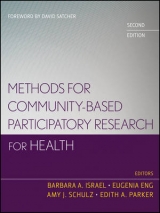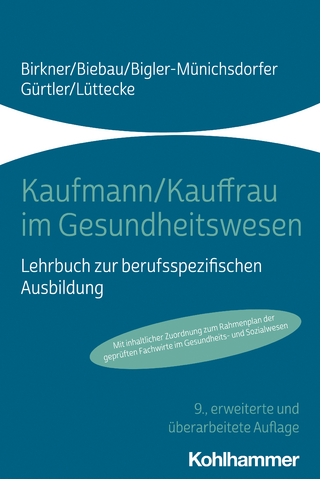
Methods in Community-Based Participatory Research for Health
Jossey-Bass Inc.,U.S. (Verlag)
978-0-7879-7562-3 (ISBN)
- Titel erscheint in neuer Auflage
- Artikel merken
This book informs students, practitioners, researchers, and community members about methods and applications needed to conduct CBPR in the widest range of research areas-including social determinants of health, health disparities, health promotion, community interventions, disease management, health services, and environmental health.
Barbara A. Israel is professor of health behavior and health education in the School of Public Health at the University of Michigan. Eugenia Eng is professor of health behavior and health education in the School of Public Health at the University of North Carolina at Chapel Hill. Amy J. Schulz is research associate professor of health behavior and health education at the University of Michigan School of Public Health. Edith A. Parker is associate professor of health behavior and health education at the University of Michigan School of Public Health.
Figures and Tables. Foreword (David Satcher). Acknowledgments. The Editors. The Contributors. PART ONE: INTRODUCTION TO METHODS IN COMMUNITY-BASED PARTICIPATORY RESEARCH FOR HEALTH. 1. Introduction to Methods in Community-Based Participatory Research for Health (Barbara A. Israel, Eugenia Eng, Amy J. Schulz, and Edith A. Parker). PART TWO: PARTNERSHIP FORMATION AND MAINTENANCE. 2. Developing and Maintaining Partnerships with Communities (Nina Wallerstein, Bonnie Duran, Meredith Minkler, and Kevin Foley). 3. Strategies and Techniques for Effective Group Process in CBPR Partnerships (Adam B. Becker, Barbara A. Israel, and Alex J. Allen III). PART THREE: COMMUNITY ASSESSMENT AND DIAGNOSIS. 4. Insiders and Outsiders Assess Who Is "The Community": Participant Observation, Key Informant Interview, Focus Group Interview, and Community Forum (Eugenia Eng, Karen Strazza Moore, Scott D. Rhodes, Derek M. Griffith, Leo L. Allison, Kate Shirah, and Elvira M. Mebane). PART FOUR: DEFINITION OF THE ISSUE. 5. CBPR Approach to Survey Design and Implementation: The Healthy Environments Partnership Survey (Amy J. Schulz, Shannon N. Zenk, Srimathi Kannan, Barbara A. Israel, Mary A. Koch, and Carmen A. Stokes). 6. Using a CBPR Approach to Develop an Interviewer Training Manual with Members of the Apsaalooke Nation (Suzanne Christopher, Linda Burhansstipanov, and Alma Knows His Gun-McCormick). 7. The Application of Focus Group Methodologies to Community-Based Participatory Research (Edith C. Kieffer, Yamir Salabarria-Pena, Angela M. Odoms-Young, Sharla K. Willis, Kelly E. Baber, and J. Ricardo Guzman). 8. Application of CBPR in the Design of an Observational Tool: The Neighborhood Observational Checklist (Shannon N. Zenk, Amy J. Schulz, James S. House, Alison Benjamin, and Srimathi Kannan). 9. Mapping Social and Environmental Influences on Health: A Community Perspective (Guadalupe X. Ayala, Siobhan C. Maty, Altha J. Cravey, and Lucille H. Webb). 10. Community-Based Participatory Research and Ethnography: The Perfect Union (Chris McQuiston, Emilio A. Parrado, Julio Cesar Olmos-Muniz, and Alejandro M. Bustillo Martinez). 11. What's with the Wheezing? Methods Used by the Seattle-King County Healthy Homes Project to Assess Exposure to Indoor Asthma Triggers (James Krieger, Carol A. Allen, John W. Roberts, Lisa Carol Ross, and Tim K. Takaro). PART FIVE: DOCUMENTATION AND EVALUATION OF PARTNERSHIPS. 12. Documentation and Evaluation of CBPR Partnerships: In-Depth Interviews and Closed-Ended Questionnaires (Barbara A. Israel, Paula M. Lantz, Robert J. McGranaghan, Diana L. Kerr, and J. Ricardo Guzman). PART SIX: FEEDBACK, INTERPRETATION, DISSEMINATION, AND APPLICATION OF RESULTS. 13. Developing and Implementing Guidelines for Dissemination: The Experience of the Community Action Against Asthma Project (Edith A. Parker, Thomas G. Robins, Barbara A. Israel, Wilma Brakefield-Caldwell, Katherine K. Edgren, and Donele J. Wilkins). 14. Creating Understanding and Action Through Group Dialogue (Elizabeth A. Baker and Freda L. Motton). 15. Photovoice as a Community-Based Participatory Research Method: A Case Study with African American Breast Cancer Survivors in Rural Eastern North Carolina (Ellen D. S. Lopez, Eugenia Eng, Naomi Robinson, and Caroline C. Wang). 16. Policy Analysis and Advocacy: An Approach to Community-Based Participatory Research (Nicholas Freudenberg, Marc A. Rogers, Cassandra Ritas, and Sister Mary Nerney). 17. Citizens, Science, and Data Judo: Leveraging Secondary Data Analysis to Build a Community-Academic Collaborative for Environmental Justice in Southern California 371 Rachel Morello-Frosch, Manuel Pastor Jr., James L. Sadd, Carlos Porras, and Michele Prichard APPENDIXES. A. Instructions for Conducting a Force Field Analysis (Adam B. Becker, Barbara A. Israel, and Alex J. Allen III). B. Community Member Key Informant Interview Guide (Eugenia Eng, Karen Strazza Moore, Scott D. Rhodes, Derek M. Griffith, Leo L. Allison, Kate Shirah, and Elvira M. Mebane). C. Selected New and Revised Items Included in the HEP Survey After Input from the Steering Committee or Survey Subcommittee (SC), Focus Group Themes (FG), or Pilot Testing (PT) of Existing Items (Amy J. Schulz, Shannon N. Zenk, Srimathi Kannan, Barbara A. Israel, Mary A. Koch, and Carmen A. Stokes). D. Selected HEP Measures by Survey Categories, with Sources and Scale Items (Amy J. Schulz, Shannon N. Zenk, Srimathi Kannan, Barbara A. Israel, Mary A. Koch, and Carmen A. Stokes). E. Healthy Environments Partnership: Neighborhood Observational Checklist (Shannon N. Zenk, Amy J. Schulz, James S. House, Alison Benjamin, and Srimathi Kannan). F. Field Notes Guide (Chris McQuiston, Emilio A. Parrado, Julio Cesar Olmos, and Alejandro M. Bustillo Martinez). G. Detroit Community-Academic Urban Research Center: In-Depth, Semistructured Interview Protocol for Board Evaluation, 1996-2002 (Barbara A. Israel, Paula M. Lantz, Robert J. McGranaghan, Diana L. Kerr, and J. Ricardo Guzman). H. Detroit Community-Academic Urban Research Center: Closed-Ended Survey Questionnaire for Board Evaluation, 1997-2002 (Barbara A. Israel, Paula M. Lantz, Robert J. McGranaghan, Diana L. Kerr, and J. Ricardo Guzman). I. Philosophy and Guiding Principles for Dissemination of Findings of the Michigan Center for the Environment and Children's Health (MCECH) Including Authorship of Publications and Presentations, Policies and Procedures, Access to Data, and Related Matters (Edith A. Parker, Thomas G. Robins, Barbara A. Israel, Wilma Brakefield-Caldwell, Katherine K. Edgren, and Donele J. Wilkins). J. Community Action Against Asthma: Fact Sheet on "Particulate Matter" (Edith A. Parker, Thomas G. Robins, Barbara A. Israel, Wilma Brakefield-Caldwell, Katherine K. Edgren, and Donele J. Wilkins). K. Community Action Against Asthma: Summary of Air Sampling Data in Your Community and Home, 2000-2001 (Edith A. Parker, Thomas G. Robins, Barbara A. Israel, Wilma Brakefield-Caldwell, Katherine K. Edgren, and Donele J. Wilkins). L. The Planning Grant: In-Depth Group Interview Protocol: Questions for Community and Coalition Members (Elizabeth A. Baker and Freda L. Motton). M. Inspirational Images Project: Fact Sheet and Informed Consent Form for Study Participants (Ellen D. S. Lopez, Eugenia Eng, Naomi Robinson, and Caroline C. Wang). N. Inspirational Images Project: Consent for Adults Who May Appear in Photographs (Ellen D. S. Lopez, Eugenia Eng, Naomi Robinson, and Caroline C. Wang). O. Community Reintegration Network: Policy Report-Coming Back to Harlem from Jail or Prison: One-Way or Round-Trip (Nicholas Freudenberg, Marc A. Rogers, Cassandra Ritas, and Sister Mary Nerney). P. Southern California Environmental Justice Collaborative (the Collaborative): Partnership Agreed upon Mechanism for Deciding on Research Activities (Communities for a Better Environment, Liberty Hill Foundation, and The Research Team). Name Index. Subject Index.
| Erscheint lt. Verlag | 29.7.2005 |
|---|---|
| Vorwort | David Satcher |
| Verlagsort | New York |
| Sprache | englisch |
| Maße | 180 x 234 mm |
| Gewicht | 854 g |
| Themenwelt | Medizin / Pharmazie ► Medizinische Fachgebiete ► Psychiatrie / Psychotherapie |
| Studium ► Querschnittsbereiche ► Prävention / Gesundheitsförderung | |
| ISBN-10 | 0-7879-7562-1 / 0787975621 |
| ISBN-13 | 978-0-7879-7562-3 / 9780787975623 |
| Zustand | Neuware |
| Haben Sie eine Frage zum Produkt? |
aus dem Bereich



